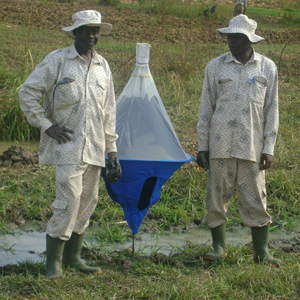Eliminating the fly or the disease?

Cattle in Burkina Faso affected by animal trypanosomosis contracts the disease not only via the tsetse fly, but also via other bloodsucking insects. The findings of a new study at the Institute of Tropical Medicine and the Ghent University indicate that campaigns focused on the eradication of tsetse flies only might be eliminating the fly, but not the disease. Animal trypanosomosis is the counterpart of human sleeping sickness.
The doctoral thesis of Adama Sow, a veterinarian and lecturer at the Ecole Inter-Etats des Science et Médecine Vétérinaire (EISMV) in Dakar (Senegal), found that direct, or mechanical, transmission of animal trypanosomiasis by insects other than the tsetse fly is high in the area surrounding the Mouhoun River, in the region of Bobo-Dioulasso. It's the first time this parameter was taken into account in an eradication programs in West Africa.
The observed predominance of livestock-infective Trypanosoma vivax (75% in the study area) is a warning signal for eradication campaigns. Sow managed to reduce the tsetse population by releasing sterile males along a branch of the Mouhoun River. These males competed with wild males for female tsetse flies that mate only once. However, the control of other blood sucking insects should be considered as Trypanosoma vivax manages to spread in Latin America and in parts of Ethiopia even when tsetse flies are not present.
Trypanosomosis infects the blood of the host, causing fever, weakness, and lethargy, which lead to weight loss and anemia. In some animals the disease is fatal unless treated. The disease is a serious economic threat in Africa, especially in Burkina Faso, where the economy relies mainly on the rural sector. It causes the death of about 3 million cattle each year. The annual losses due to the disease are estimated at about 2-4 billion euro.
To eliminate this scourge in Africa, in 2000 heads of states and governments of the African Union created the Pan African Tsetse and Trypanosomiasis Eradication Campaign (PATTEC). Sow performed his research in the context of this campaign.
ITM is at the forefront of the fight against human and animal sleeping sickness. ITM scientists study the mechanisms that cause the diseases, the stage determination and the follow-up of patients. They also develop serological and molecular tests and research interactions between trypanosomes, the fly and its symbionts, the genetic basis of drug resistance.
More information: Trypanosomosis risk factors and impact assessment of a tsetse and trypanosomosis eradication campaign in Burkina Faso - Thesis by Adama Sow
Burkina Faso country map
Map with locations of study sites
Provided by Institute of Tropical Medicine Antwerp

















